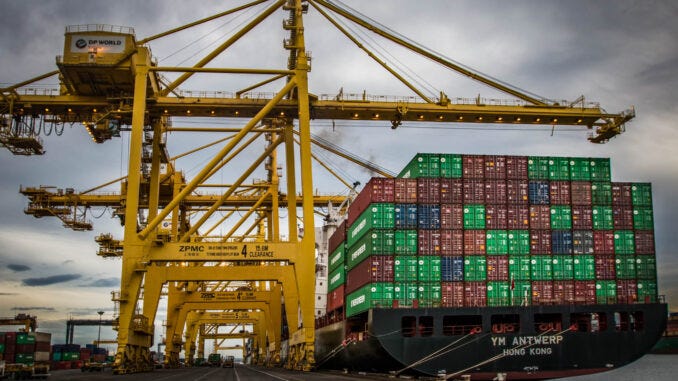What to expect as the dockworkers’ strike continues
Prepare for price hikes and product shortages. But, to quote the Hitchhiker's Guide to the Galaxy, "Don’t panic."
As port workers strike along the East and Gulf coasts, American consumers are bracing for disruptions in their daily lives. Many are already noticing certain items disappearing from store shelves and the media is filled with videos of people panic buying household staples like… wait for it… toilet paper. (As an aside, it seems like when there’s a crisis in this country, we become scatologically obsessed. So bizarre!)
While some products will definitely become scarce due to the strike, there is no need to hoard. The more important takeaway is that we can expect price increases on many of the things we buy regularly, so to reiterate: stock up but don’t hoard.
Here's a breakdown of some of the products most likely to see shortages and price increases as the strike (or perhaps, if the strike) drags on:
1. Fresh fruits and vegetables
Much of America’s fruit supply — especially bananas, mangoes, pineapples, berries, and avocados — comes from Latin America and other regions through international shipping routes. As port workers strike, these imports face delays and potential spoilage due to bottlenecks at major ports.
As fresh produce relies on timely transport to avoid spoilage, delays will lead to a reduction in supply. Retailers will have to raise prices to cover the costs of lost goods, and consumers will likely face higher costs for imported fruits and vegetables. Local produce might still be available, but expect exotic fruits and imported vegetables to be harder to find and more expensive in the coming weeks.
2. Alcohol, especially imported wine and spirits
The US imports a significant amount of its alcohol, with wines from Europe, rums from the Caribbean, and beer from Mexico topping the list of popular imports. As the ongoing strike disrupts shipping routes, many of these products will face delays, limiting supply and driving up costs for retailers.
Reduced inventory, combined with increased shipping and handling costs, will lead to higher prices for imported alcohol. While domestic brands may not be as affected, consumers with a taste for international wines and liquors should expect to pay more for these items in the near future.
As the holiday season approaches, the alcohol supply chain could face significant stress, further limiting access to these imported goods. Stocking up on your favorite imported beverages before prices spike might be a smart move.
3. Electronics
The electronics industry is particularly sensitive to supply chain disruptions. Many components and finished products, such as smartphones, laptops, gaming consoles, and televisions, are manufactured overseas — particularly in countries like China, South Korea, and Japan — and imported through US ports.
These disruptions could lead to stock shortages at retailers, especially with the holiday shopping season approaching. Retailers may raise prices to capitalize on limited inventory or to cover increased costs due to shipping delays. Additionally, the tech industry may pass on the costs of these disruptions to consumers in the form of higher prices. If you’re in the market for a new phone or a high-demand tech gadget, now might be a good time to make those purchases.
4. Clothing and apparel
The fashion industry is heavily reliant on global supply chains, with many garments and textiles manufactured overseas in countries like China, Bangladesh, and Vietnam. The strike has already begun to disrupt clothing imports, leading to delayed shipments and potential shortages on store shelves.
As fewer shipments make it through ports, retailers will likely face increased costs to secure their inventory, whether through expedited shipping options or by dealing with higher shipping fees. This will lead to price increases on clothing items, particularly for international brands or items made overseas. Seasonal items and fashion trends may also become more expensive as inventory becomes limited. Shoppers could see fewer options on store racks and higher prices for imported fashion items.
5. Automotive parts and vehicles
The automotive industry relies heavily on imported parts and components from global suppliers, and many of these products come through US ports. While domestic car manufacturers may be less affected, those who rely on foreign-made vehicles or parts are likely to see prices rise due to the strike.
A shortage of imported parts could slow down production and repair services, leading to higher costs for both new vehicles and auto repairs. Consumers may also face delays in receiving imported vehicles, further driving up demand and prices for cars already in stock.
6. Furniture and home goods
As with much of the supply chain, furniture and home goods sold in the US come from countries like China, Vietnam, and other regions. These bulky items are typically transported via sea freight and are particularly vulnerable to port delays.
As shipments of furniture are delayed or stuck at ports, retailers may face increased costs for storage, expedited shipping, or lost inventory. These costs will likely be passed on to consumers in the form of higher prices for both imported furniture and domestic goods that rely on imported materials.
7. Imported packaged foods
While fresh produce will be hit hard by delays, packaged foods that rely on international ingredients or are imported as finished goods will also see price increases. Items like pasta, olive oil, coffee, and chocolate that are sourced from abroad will become more expensive as supply chains are disrupted.
Limited availability of these imported goods combined with increased shipping and handling costs will cause prices to rise. Specialty food items and gourmet products that are imported from specific regions will be particularly affected.
Even though some items, like toilet paper, are made domestically and not directly affected by the port strike, the overall impact on the supply chain could lead to indirect price increases. As imported goods become scarcer and more expensive, demand for domestic products may rise, driving up prices for household items that are still readily available. Additionally, if transportation networks become further strained, the cost of shipping goods across the US could increase, leading to price hikes for a wider range of products.
While consumers should prepare for price increases, panic purchasing or engaging in widespread hoarding help drive forces of inflation. Best to stay informed and plan purchases thoughtfully as a way to help navigate supply chain disruptions. By focusing on products that are most at risk for price hikes and shortages, shoppers can make smarter decisions during this period of uncertainty.
Given this entire situation is inflationary in nature, combined with all the other concurrent crises we are facing as a nation, the real question that needs to be asked is: Got gold?





Well, that de-escalated quickly